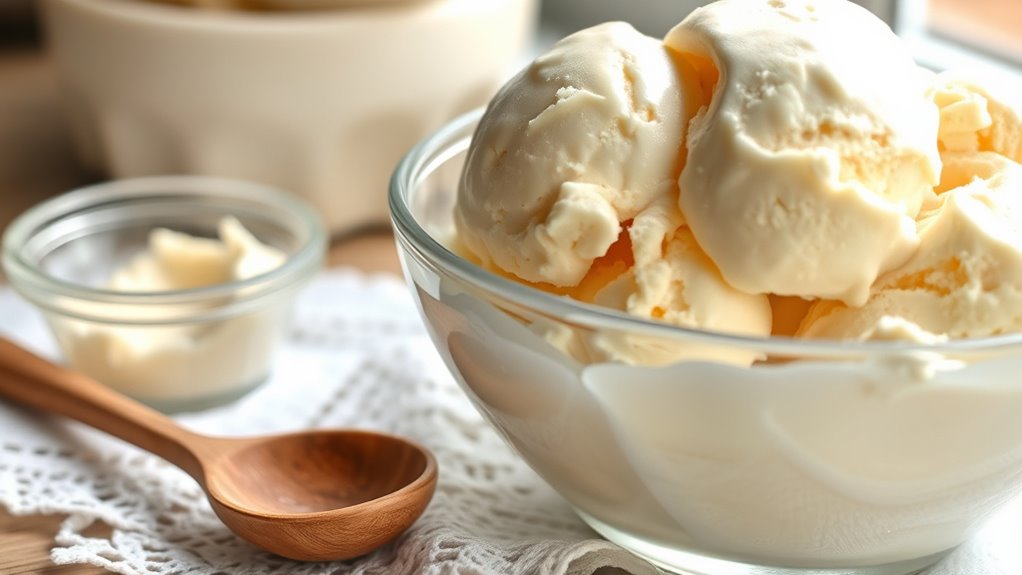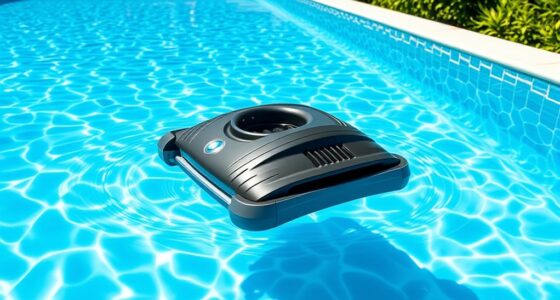Homemade ice cream can go bad if it’s not stored properly, showing signs like off smells, changes in texture, or ice crystals. Proper freezing techniques and airtight containers help extend its freshness and prevent freezer burn. Keep your ice cream at 0°F (-18°C), and avoid frequent temperature fluctuations. If you’re curious about how to keep your homemade treats safe and delicious longer, there’s more you should know to master storage secrets.
Key Takeaways
- Homemade ice cream can spoil, showing signs like off odors, grainy or slimy textures, and ice crystals.
- Proper storage in airtight containers at 0°F (-18°C) extends freshness and prevents freezer burn.
- Freezing techniques like rapid freezing and leaving space for expansion help maintain texture.
- Thaw in the refrigerator and avoid refreezing to prevent bacterial growth and texture deterioration.
- Regularly check for spoilage signs such as unusual smells or textures before serving.
Understanding How Homemade Ice Cream Spoils
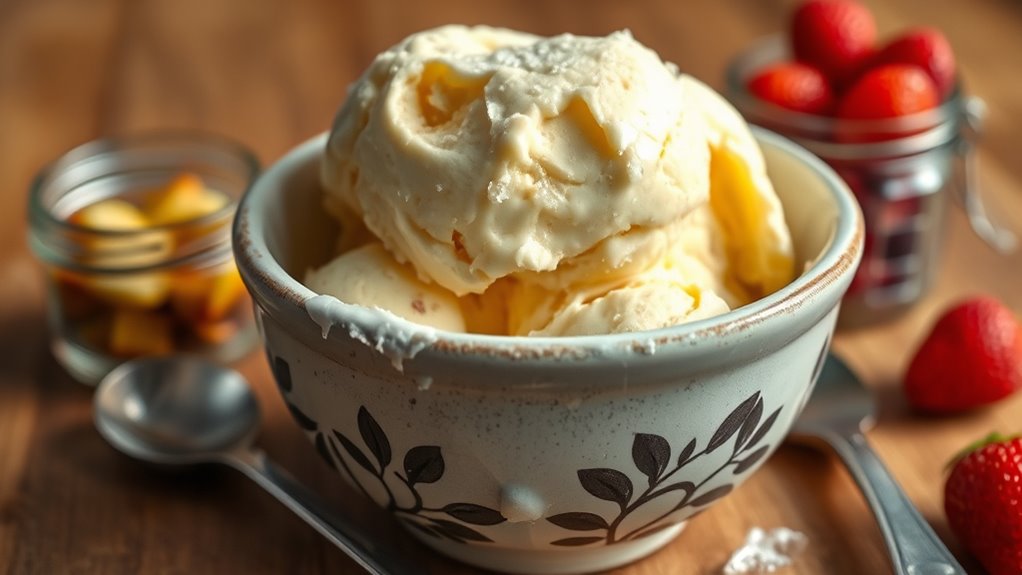
Understanding how homemade ice cream spoils is essential to enjoying it safely. When it sits too long, flavor preservation diminishes as ingredients break down, leading to off-flavors. Over time, the stability of ingredients like dairy, fruit, or add-ins can weaken, causing texture changes or separation. Freezing slows spoilage, but it doesn’t stop it entirely; enzymes and bacteria remain active at low temperatures. Exposure to air or temperature fluctuations accelerates spoilage by introducing moisture or encouraging microbial growth. Proper storage guarantees that ingredient stability remains intact longer, maintaining the ice cream’s freshness and flavor. Additionally, bacterial growth can occur even in frozen desserts if not stored properly. Using appropriate storage techniques is crucial to prevent spoilage and extend shelf life. Ensuring the freezer maintains a consistent temperature is also vital, as fluctuations can compromise quality. Regularly monitoring the freezer temperature helps prevent unexpected spoilage. Knowing these factors helps you prevent spoilage, so your homemade ice cream stays delicious and safe for as long as possible. The use of air-tight containers can significantly extend the shelf life by reducing exposure to oxygen, which accelerates deterioration.
Recognizing Signs That Ice Cream Has Gone Bad
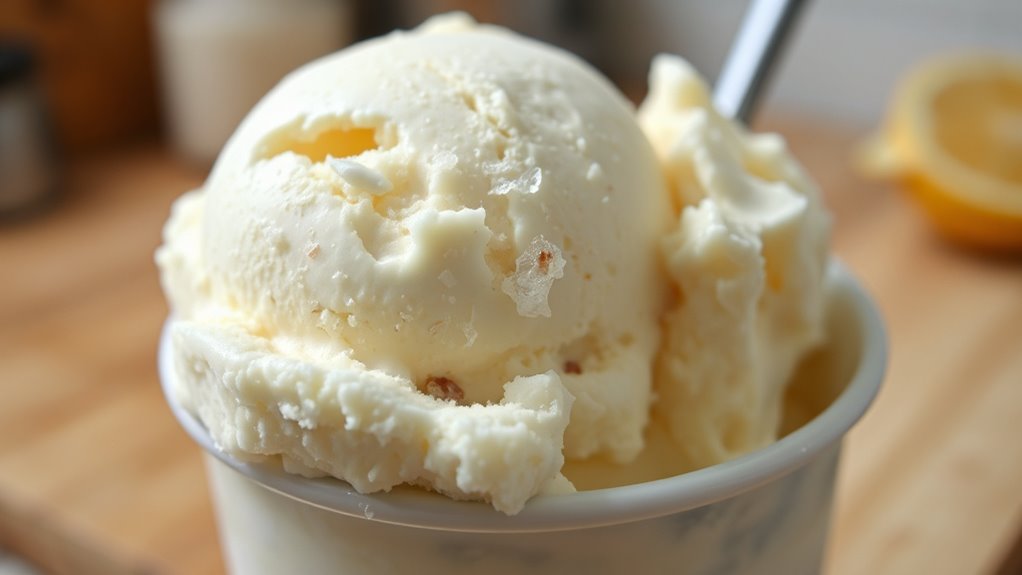
You should always trust your senses to tell if your ice cream has gone bad. If it smells off or has a strange odor, it’s time to toss it. Unusual textures or the presence of ice crystals are also clues that it’s no longer safe to enjoy. Additionally, proper storage in an airtight container can help prevent spoilage and freezer burn.
Off-Putting Odor Detected
When you open your homemade ice cream and notice a strange, off-putting smell, it’s a clear sign that something’s wrong. Odor detection is key to identifying spoiled ice cream, as a sour or rancid scent indicates bacterial growth or freezer burn. If the scent is strong and lingering, it’s best to discard the ice cream to avoid health risks. Proper scent preservation during storage helps prevent off-putting odors, so always use airtight containers and keep the freezer sealed tight. An unusual smell isn’t normal and shouldn’t be ignored, even if the ice cream looks fine. Trust your nose—if the aroma feels off, it’s time to throw it out. Recognizing these signs saves you from consuming spoiled ice cream and ensures your safety. Additionally, understanding proper storage techniques can help extend the freshness of homemade ice cream and prevent these issues. Incorporating proper storage methods is especially crucial as they are aligned with best practices for maintaining food quality and safety. Proper temperature control is essential because fluctuations can accelerate spoilage and odor development, making vigilant monitoring a key part of ice cream storage.
Unusual Texture Changes
If your homemade ice cream develops an unusual texture, it’s a strong sign that something’s gone wrong. You might notice it becoming grainy, icy, or slimy, which indicates spoilage or improper storage. An unusual texture often accompanies flavor inconsistencies, such as sour or off-tasting notes, confirming that the ice cream has gone bad. These texture changes happen when the fat or water components separate or when bacteria and mold grow, altering the original creamy consistency. Improper storage conditions can accelerate these changes and promote spoilage. Additionally, understanding proper storage techniques from hackathons can help you maintain optimal freshness and safety for your homemade ice cream. Recognizing these texture shifts helps you prevent consuming spoiled ice cream and ensures your homemade treats stay fresh and safe for future enjoyment. Staying informed about food safety practices is essential to prevent health risks associated with spoiled desserts.
Visible Ice Crystals
Visible ice crystals on the surface or throughout your homemade ice cream are clear indicators that it has gone bad. Frost formation and ice crystal growth signal improper storage or temperature fluctuations. When you notice large, cloudy ice crystals, it means the quality has deteriorated, and the texture may be compromised. These crystals often result from repeated freeze-thaw cycles, causing moisture to migrate and form frost. Proper storage techniques prevent ice crystal growth can help prevent these issues and extend the shelf life of your ice cream. Maintaining a consistent freezer temperature is essential because fluctuations can accelerate ice crystal formation and spoilage. Additionally, understanding freezer temperature and maintaining it consistently can significantly reduce the formation of unwanted ice crystals. Using a reliable freezer thermometer can help monitor and keep the temperature stable, ensuring your homemade ice cream stays fresh longer.
Proper Techniques for Freezing and Storing Your Ice Cream
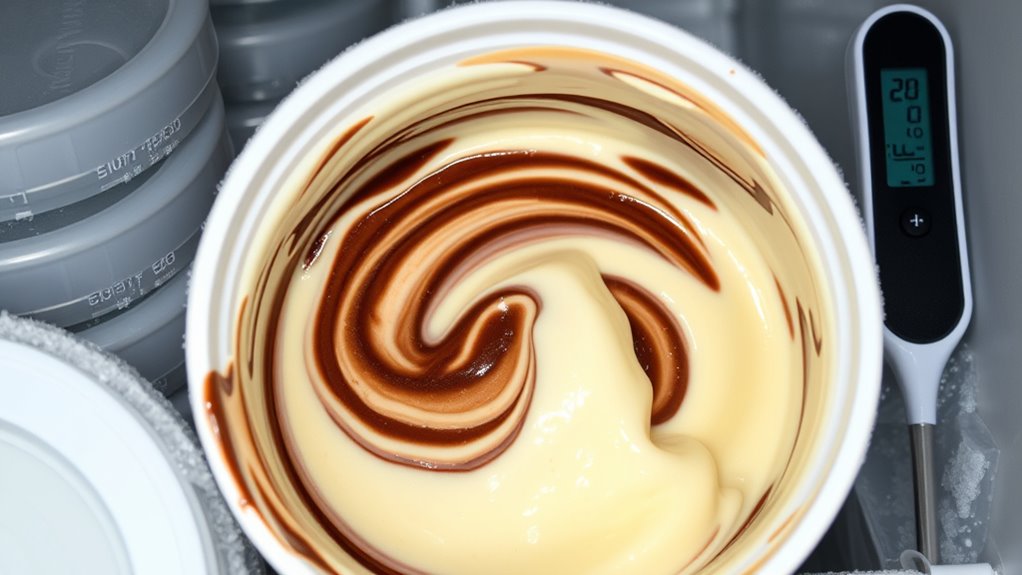
To keep your homemade ice cream fresh, it’s vital to use the best freezing methods. Proper storage practices also play a key role in maintaining quality and preventing freezer burn. By following these techniques, you’ll guarantee your ice cream stays delicious for longer. Additionally, understanding cookie categories helps optimize storage conditions and ensures your ice cream remains in top condition. Utilizing proper storage practices can also help preserve the flavor and texture of your homemade ice cream over time. Consulting best storage techniques can further enhance your ability to keep ice cream fresh and prevent spoilage. Proper freezing duration is essential to avoid quality loss and ensure optimal taste and texture.
Optimal Freezing Methods
Proper freezing techniques are essential to preserve the texture and flavor of your homemade ice cream. To guarantee ideal results, use airtight containers to prevent freezer burn and flavor mixing. Make sure to level the surface and leave space for expansion. For flavor variations, consider adding mix-ins before freezing, but avoid overloading the container. If you’re experimenting with ingredient substitutions, remember that some dairy alternatives may require different freezing times. Rapid freezing helps maintain a smooth texture by reducing ice crystal formation. Additionally, wrapping the container tightly with plastic wrap before sealing it with the lid provides extra protection. Incorporating proper freezing methods ensures your ice cream retains its quality and scoopability longer, no matter the flavor variations or ingredient substitutions you choose.
Best Storage Practices
For the best results, focus on proper freezing and storage techniques to keep your homemade ice cream fresh and scoopable. Use an airtight container and press a piece of plastic wrap directly on the surface to prevent ice crystals. Label your containers with flavor variations so you can easily identify them later. Store your ice cream in the coldest part of the freezer, ideally at 0°F (-18°C), to maintain quality. When trying new homemade ice cream recipes, avoid overfilling containers to allow space for expansion. Consistent storage methods ensure your ice cream maintains its flavor and texture longer. Properly stored, your homemade ice cream will stay delicious and scoopable, letting you enjoy your favorite flavor variations anytime.
Best Containers and Packaging for Longevity
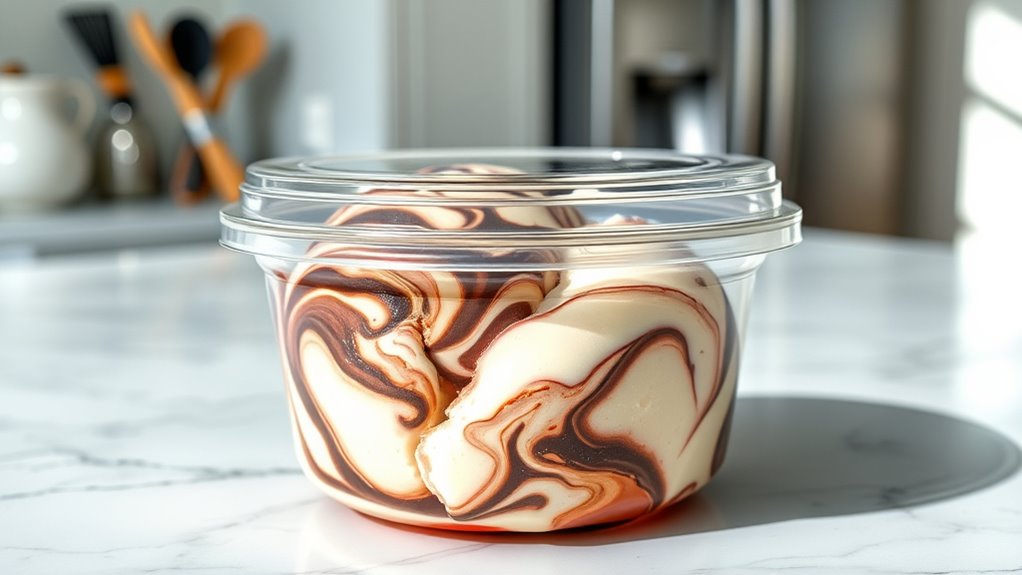
Choosing the right containers is essential if you want your homemade ice cream to stay fresh and maintain its quality over time. The best packaging material options help prevent freezer burn, preserve flavor variations, and extend shelf life. Opt for airtight containers with tight-fitting lids to minimize air exposure. Consider using metal or high-quality plastic containers that won’t crack or absorb odors. Silicone molds or resealable bags can also work for smaller portions or experimentations with flavor variations. Avoid thin plastics that can cause freezer burn or transfer flavors. For added freshness, wrap the surface of the ice cream with parchment paper before sealing. Remember, proper packaging not only preserves your ice cream but also ensures your flavor variations stay distinct and delicious longer.
Choose airtight containers and wrap with parchment to keep your homemade ice cream fresh and flavorful longer.
- Airtight plastic or metal containers
- Glass containers with tight lids
- Silicone molds and resealable bags
- Parchment paper for surface sealing
- Packaging material options that prevent odor absorption
Tips for Extending the Freshness of Homemade Ice Cream

To keep your homemade ice cream tasting fresh longer, it’s important to handle it carefully during storage. First, always store it in an airtight container to prevent exposure to air, which can cause flavor loss and freezer burn. Press a piece of plastic wrap directly on the surface before sealing the lid to minimize ice crystals and preserve ingredient freshness. Keep your ice cream at a consistent, cold temperature—ideally around 0°F (-18°C)—to slow down flavor degradation. Avoid frequent opening and closing, which introduces moisture and affects texture. Additionally, choose containers that prevent odors from seeping in, maintaining the true flavor profile. Following these tips helps preserve flavor and ingredient freshness, ensuring your homemade ice cream stays delicious for as long as possible.
Safe Thawing and Serving Practices
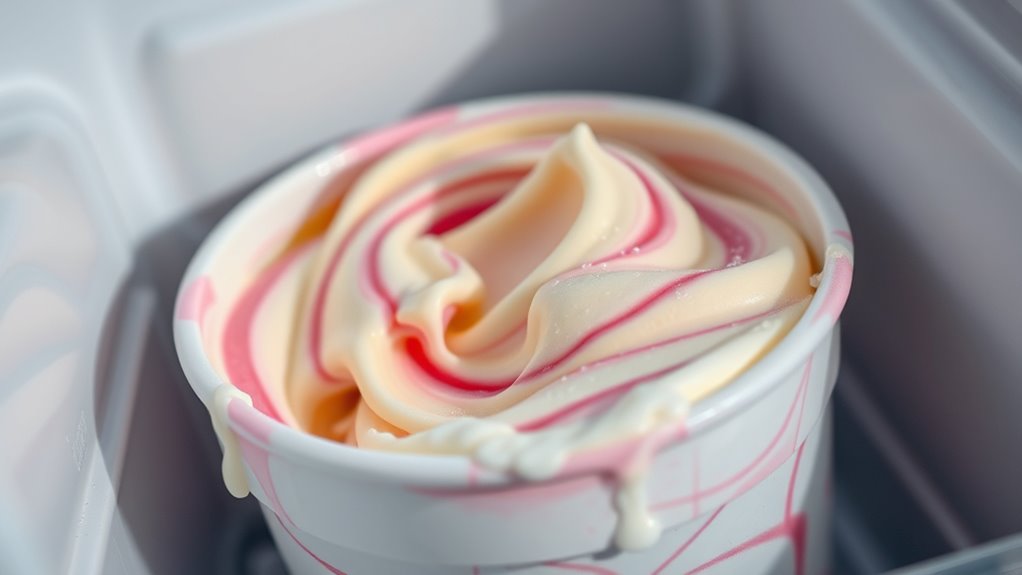
Proper thawing and serving practices guarantee your homemade ice cream remains safe to enjoy and retains its best texture. To assure dairy ingredient safety, always thaw your ice cream in the refrigerator rather than at room temperature, which can promote bacterial growth. Keep in mind that commercial ice creams often contain preservatives and stabilizers, unlike homemade versions, so handle each appropriately. When serving, use clean utensils to prevent contamination. Avoid refreezing thawed ice cream, as it can compromise safety and texture. Additionally, be mindful of storage duration; even properly stored homemade ice cream should be consumed within a few weeks.
Thaw in the fridge, use clean utensils, avoid refreezing, and check for spoilage before serving.
- Thaw in the fridge, not at room temperature
- Use clean utensils each time
- Avoid refreezing once thawed
- Check for signs of spoilage before serving
- Understand differences between commercial and homemade dairy safety
Frequently Asked Questions
How Long Can Homemade Ice Cream Be Stored Safely?
You can typically store homemade ice cream safely for up to two weeks in your freezer. To prevent spoilage, make sure it’s kept at a consistent, cold temperature and tightly sealed. Watch for spoilage signs like ice crystals, freezer burn, or an off smell. If you notice any of these, it’s best to discard it. Proper storage duration and keeping an eye on spoilage signs help maintain its quality and safety.
Can Homemade Ice Cream Develop Bacteria if Left Out?
Think of your homemade ice cream as a delicate snowflake—beautiful but vulnerable. If left out, bacterial growth can sneak in, turning your treat into a spoilage risk. Bacteria thrive in warm environments, so leaving ice cream out invites bacteria to multiply rapidly. To keep it safe and delicious, always store it in the freezer and avoid leaving it at room temperature for too long, protecting your sweet creation from hidden dangers.
Does Adding Alcohol Help Preserve Homemade Ice Cream?
Adding alcohol to your homemade ice cream can help with alcohol preservation and flavor enhancement. The alcohol lowers the freezing point, making it less likely to develop ice crystals and spoil quickly. Plus, it adds a unique taste to your dessert. Just remember, too much alcohol can affect the texture, so use it sparingly. This simple trick extends freshness and boosts flavor, ensuring your ice cream stays delicious longer.
Can Homemade Ice Cream Be Refrozen After Partially Thawed?
If your homemade ice cream has partially thawed, you can refreeze it, but keep in mind the refreezing safety and texture changes. You might notice ice crystals or a grainy texture after refreezing, which affects quality. To minimize these issues, try to refreeze quickly and avoid repeatedly thawing and refreezing. While it’s generally safe, the texture might not be as smooth, so use your judgment before serving.
What’s the Best Way to Prevent Ice Crystals From Forming?
To prevent ice crystal formation and freezer burn, you should store your homemade ice cream properly. Use airtight containers to minimize air exposure, which helps with freezer burn prevention. Cover the surface with plastic wrap before sealing, and keep the freezer at a consistent, cold temperature. Regularly check your ice cream and avoid opening the container often. These steps keep your ice cream smooth, creamy, and free of unwanted ice crystals.
Conclusion
Now, next time you whip up a batch of homemade ice cream, remember these storage secrets—because sometimes, the difference between a delicious treat and a freezer burn surprise is just a few simple steps. It’s funny how a little extra care can keep your ice cream tasting fresh longer, almost like magic. So, enjoy your homemade creations, knowing you’ve revealed the secret to lasting freshness—your taste buds will thank you!
